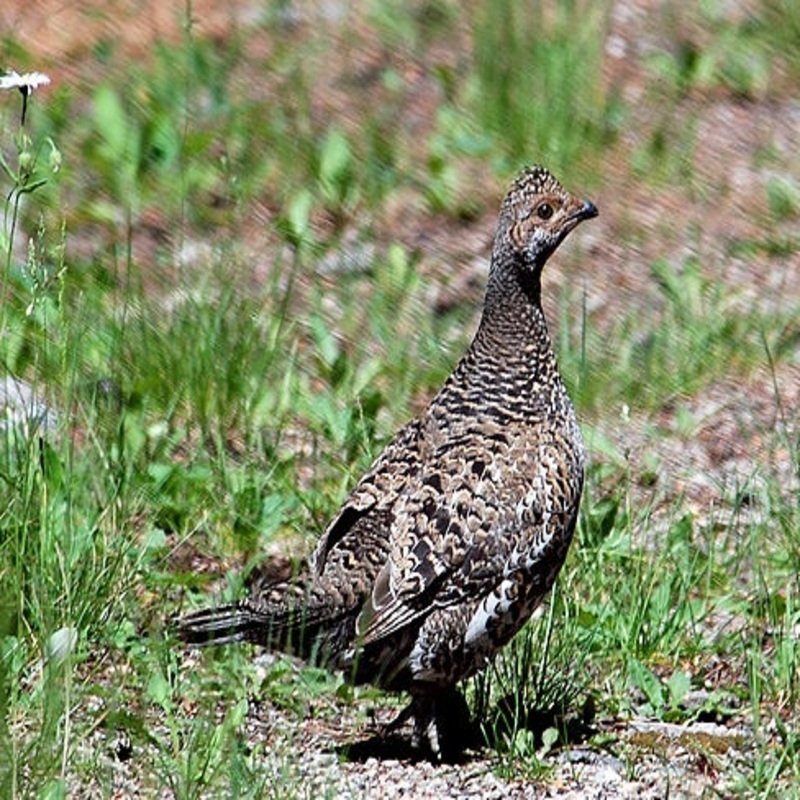The dusky grouse, Dendragapus obscurus is a forest-dwelling grouse native to North America’s Rocky Mountains and North America’s third-biggest grouse. It belongs to the family of Phasianidae. It was once considered a single species, the blue grouse, with the sooty grouse (Dendragapus fuliginosus). The majority of bird species have a fixed number of tail feathers (rectrices), generally about ten.
Quick Overview: Dendragapus Obscurus – Dusky Grouse
Body size: Around 19-21 in (48-53 cm) and a weight of 1179 g (41.6 oz)
Main colors: Gray, White, Gray-brown
Range: Rocky Mountains of United States
Migratory Bird: No
Best time of the year to see in the U.S.: All Year (January – December)
Conservation Status: Least Concern
Dusky Grouse Description
The dusky grouse is the second biggest grouse in North America, behind the sage grouse. With males being bigger than females. Males and females look the same at first glance. Males are slate gray with white highlights, while females are grayish-brown with white highlights. A gray ring runs around the tip of the tail feathers of both sexes. This band is particularly visible in males during the spring mating season when they fan their tail out to attract a female. Dusky grouse have a noticeable eye comb in the spring.

Size
These birds have a length of 19-21 in (48-53 cm) and a weight of 1179 g (41.6 oz). Their wings could range from 24-28 in (61-71 cm).
Feeding
It feeds on the needles and cones produced by spruce, Douglas fir, and other conifer trees. This time of year, whitebark pine cone seeds are a favorite. It is heavy in protein and fat and offers these birds essential nutrients during the winter months. During the summer, dusky grouse eat a blueberry, chokecherry, gooseberry, and huckleberry berries.
Habitat
Dusky grouse inhabit a variety of habitats, from aspen and sagebrush along the coast to deep Douglas fir, lodgepole pine, and spruce forests above the tree line. They utilize these places for various functions and travel between them. Summer feeding grounds include sub-alpine meadows and low-lying regions with aspen, chokecherry, serviceberry, and oak scrub. These plants, along with grasshoppers, are important food sources for dusky grouse now. During the winter, when most mountain animals migrate to lower heights, dusky grouse stay near the tree line at high elevations.
Behavior
Its ecosystems range from aspen-sagebrush near the shore to thick Douglas fir, lodgepole pine, and spruce forests above the tree line. Every year they move between these locations. In sub-alpine meadows, these birds feed on aspen, chokecherry, serviceberry, and oak scrub. This time of year, dusky grouse and grasshoppers eat a lot of these plants. Dusky grouse winter at the tree line, but most other mountain species do not.
Dendragapus Obscurus Scientific Classification
- Kingdom: Animalia
- Phylum: Chordata
- Subphylum: Chelicerata
- Class: Aves
- Order: Galliformes
- Family: Phasianidae
- Genus: Dendragapus
- Species: Dendragapus obscurus
Best time of the year to see
In the United States, the best time of year to see these birds is all year round, regardless of the season. This refers to any month of the year between January and December.
Distribution of the Dusky Grouse in the USA
From the Yukon and Northwest Territories through most of British Columbia, and south through the Rocky Mountains to Arizona, Colorado, and New Mexico, this species is a resident.
The Dusky Grouse can be found in the following states in the United States – California, Idaho, Nevada, Montana, Oregon, Utah, Washington, and Wyoming.

